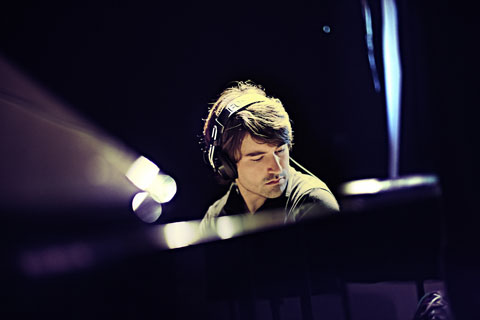
FORMAL ATTIRE “If Bach weren’t quite as good as he was,” says Dan Tepfer, “he would be insanely boring.”
|
Jazz and Bach have always made good company, so it’s no huge surprise that the formally rigorous 30-year-old jazz pianist and composer Dan Tepfer would take on The Goldberg Variations. After all, an “aria,” with 30 variations built on basslines and chord progressions – what could be more jazz than that? So Tepfer – who has been fascinated by Bach for most of his life – finally got around to recording his take on Bach, Goldberg Variations/Variations in May and June of last year, and now out on Sunnyside. Tepfer brings the Goldbergs to the Regattabar next Wednesday, April 25.
Or at least part of them. Tepfer’s disc runs 77 minutes and 44 seconds – each of Bach’s variations followed by Tepfer’s improvisation on the same. It’s not just the demands on the audience and himself that such a piece would make in live performance but also, he points out on the phone from New York, “Live, it’s always longer, right?” So Tepfer will probably begin the show with a couple of introductory pieces and then play the first 15 Goldergs with his own improvisations – about 50 minutes. Variation 15, he says, is a good end point, since Variation 16, the French Overture, acts as an introduction to the piece’s second half.
The son of two Americans living in Paris, Tepfer studied classical piano at the Paris Conservatory. An improviser from an early age, he remembers as an “eight or nine-year-old thinking that I would love to be able to improvise counterpoint the way Bach does.” He first heard a recording of the Goldberg Variations when he was a teen and eventually bought a score and began studying them. When he moved to New York, he continued to study with a Juilliard instructor, Zitta Zohar. Although he at first only intended them as pieces for study and practice, they started showing up in his performances. And when it was time to put them on disc, he decided he wanted to record them all.
At first he envisioned a double-CD, but as he worked on the Variations, he realized that he wanted something “structurally tight” that would fit all on one CD. Also, he said, he wanted to “preserve the arc” or the original.
That “arc” might not be immediately apparent in these “keyboard studies,” but Tepfer points out that “there really is a clear arc. It really goes somewhere. It’s kind of telling a story.”
Bach grouped his variations in threes – the first based on some dance form of the era (gavotte, gigue, sarabande), the second a virtuoso display, the third a canon. Tepfer points out that the piece as a whole runs the gamut of emotions – some are more uptempo and “crazy-happy” playful, some more stately or introspective. Bach’s formal ingenuity is of a piece with his emotional expression, especially in his use of the double-voice canon form —as the variations develop, the two voices move further apart, from “Canon on the Unison” to Canon on the Ninth.” Tepfer points out that by Variation 25, the piece has become “dark with chromaticism and dissonance.”